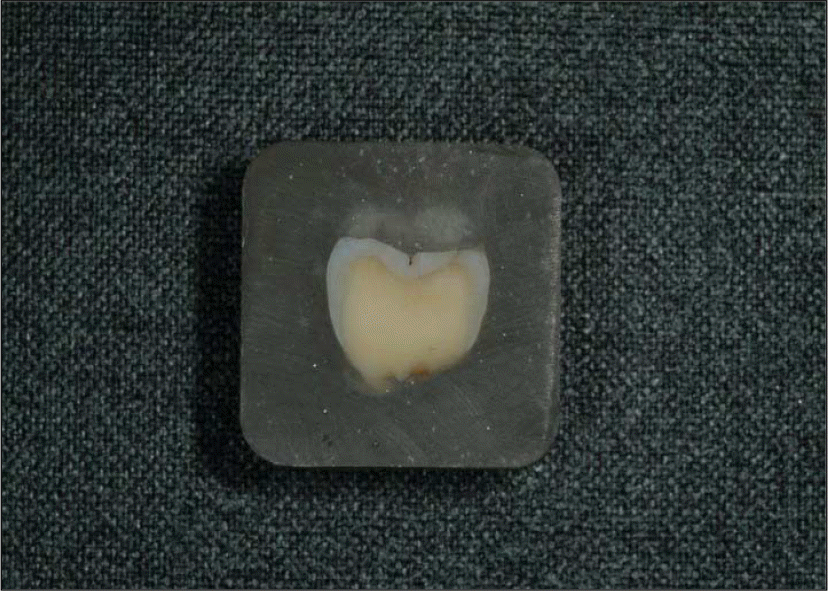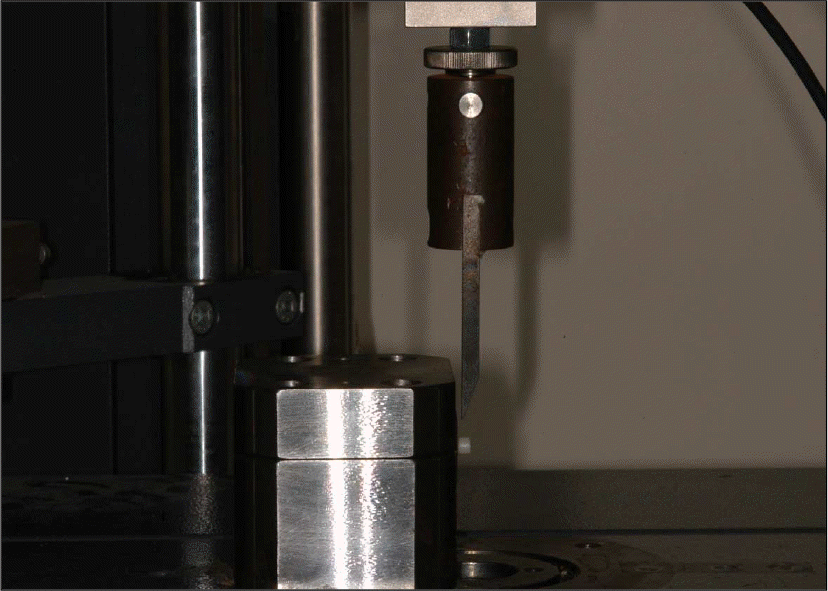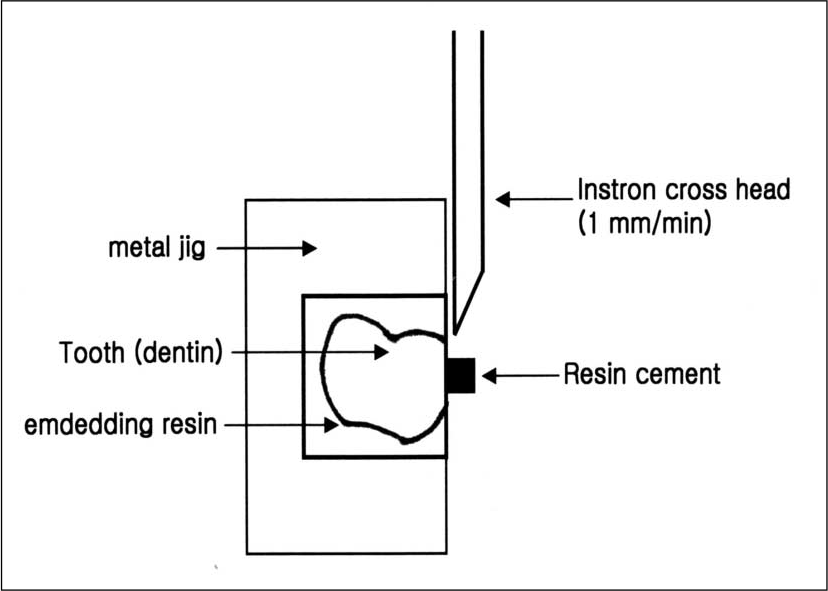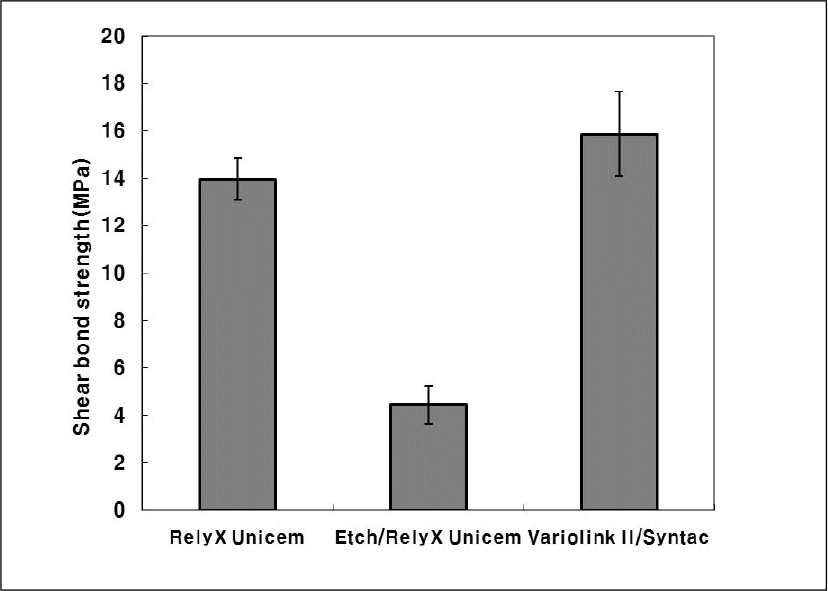Abstract
Purpose
The objective of this study was to compare the bonding characteristics of a new self-adhesive resin cement to dentin, which does not require bonding and conditioning procedure of the tooth surface, and conventional resin cement. The effect of phosphoric acid etching prior to application of self-adhesive resin cement on the shear bond strength was also evaluated.
Material and methods
Fortyfive non-carious human adult molars extracted within 6 months were embedded in chemically cured acrylic resin. The teeth were ground with a series of SiC-papers ending with 800 grit until the flat dentin surfaces of the teeth were exposed. The teeth were randomly divided into 3 experimental groups. In group 1, self-adhesive resin cement, RelyX Unicem (3M ESPE, Seefeld, Germany) was bonded without any conditioning of teeth. In group 2, RelyX Unicem was bonded to teeth after phosphoric acid etching. For group 3, Syntac Primer (Ivoclar Vivadent AG, Schaan, Liechtenstein) was applied to the teeth before Syntac adhesive (Ivoclar Vivadent AG, Schaan, Liechtenstein) and Helibond (Ivoclar Vivadent AG, Schaan, Liechtenstein) followed by conventional resin cement, Variolink II (Ivoclar Vivadent AG, Schaan, Liechtenstein). To make a shear bond strength test model, a plastic tuble (3 mm diameter, 3 mm height) was applied to the dentin surfaces at a right angle and filled it with respective resin cement, and light-polymerized for 40 seconds. All the specimens were stored in distilled water at 37℃ for 24 hours before test. Universal Testing Machine (Z020, Zwick, Ulm, Germany) at a cross head speed of 1 mm/min was used to evaluate the shear bond strength. The failure sites were inspected under a magnifier and Scanning Electron Microscope. The data was analyzed with One way ANOVA and Scheffe test at α = 0.05.
Results
(1) The shear bond strengths to dentin of RelyX Unicem was not significantly different from those of Variolink II/Syntac. (2) Phosphoric acid etching lowered the shear bond strength of RelyX Unicem significantly. (3) Most of RelyX Unicem and Variolink II showed mixed fractures, while all the specimens of RelyX Unicem with phosphoric acid etching demonstrated adhesive failure between dentin and resin cement.
Go to : 
REFERENCES
1.Pro¨bster L. Survival rate of In-Ceram restoration. Int J Prosthodont. 1993. 6:259–63.
2.Tjan AH., Dunn JR., Grant BE. Marginal leakage of cast gold crowns luted with an adhesive resin cement. J Prosthet Dent. 1992. 67:11–5.
3.Anusavice KJ. Phillips science of dental materials.11th ed. Saunders, Missouri, USA;2003. p. 443–94.
4.Dixon DL., Breeding LC., Hughie ML., Brown JS. Comparison of shear bond strengths of two resin luting systems for a base and a high noble metal alloy bonded to enamel. J Prosthet Dent. 1994. 72:457–61.

5.Groten M., Pro¨bster L. The influence of different cementation modes on the fracture resistance of feldspathic ceramic crowns. Int J Prosthodont. 1997. 10:169–77.
6.Eden GT., Kacicz JM. Dicor crownstrength improvement due to bonding (abstract). J Dent Res. 1987. 66:207.
7.Roulet JF., So¨derholm KJ., Longmate J. Effects of treatment and storage conditions on ceramic/composite bond strength. J Dent Res. 1995. 74:381–7.

8.Stangel I., Nathanson D., Hsu CS. Shear strength of the composite bond to etched porcelain. J Dent Res. 1987. 66:1460–5.

9.Gerth HU., Dammaschke T., Zu¨chner H., Scha¨fer E. Chemical analysis and bonding reaction of RelyX Unicem and Bifix composites - A comparative study. Dent Mater J. 2006. 22:934–41.
10.3M ESPE. Wissenschaftliches Produktdossier RelyX Unicem. 3M ESPE AG, 82229 Seefeld, Germany.
11.Timmons S., Cobb D., Stanford C., Dawson D., Denehy J., Vargas M. Post-operative sensitivity of bonded ceramic posterior inlays and onlays. J Dent Res. 2004. 83(Spec Iss A):1538.
12.Cobb D., Timmons S., Stanford C., Dawson D., Denehy G., Vargas M. Clinical outcomes of ceramic inlays/onlays luted with two bonding systems. J Dent Res. 2004. 83(Spec Iss A):1539.
13.Benelli EM., Serra MC., Rodrigues AL Jr., Cury JA. In situ anticariogenic potential of glass ionomer cement. Caries Res. 1993. 27:280–4.
14.Technical data sheet: Espertise RelyX Unicem (2002) 3M ESPE, seefeld Germany.
15.Behr M., Rosentritt M., Regnet T., Lang R., Handle G. Marginal adaptation in dentin of a self-adhesive universal resin cement compared with well-tried systems. Dent Mater J. 2004. 20:191–7.

16.Piwowarczyk A., Laucer HC., Sorensen JA. In vitro shear bond strength of cementing agents to fixed prosthodontic restorative materials. J Prosthet Dent. 2004. 92:265–73.
17.de Souza Costa CA., Hebling J., Randall RC. Human pulp response to resin cements used to bond inlay restorations. Dent Mater J. 2006. 22:954–62.

18.Platt JA. Resin cements into the 21st century. CompCont Edue Dent. 1999. 20:1173–88.
19.White SN., Sorensen JA., Kang SK., Caputo AA. Microleakage of new crown and fixed Partial denture luting agents. J Prosthet Dent. 1992. 67:156–61.

20.Kramer N., Lohbauer U., Frankenberger R. Adhesive luting of indirect restorations. Am J Dent. 2000. 13:60–76.
21.Hasegawa EA., Boyer DB., Chan DC. Hardening of dual-cared cements under composite resin inlays. J Prosthet Dent. 1991. 66:187–92.
22.Abo-Hamar SE., Hiller KA., Jung H., Federlin M., Friedl KH., Schmalz G. Bond strength of a new universal self-adhesive resin luting cement to dentin and enamel. Clin Oral Investig. 2005. 9:161–7.

23.De Munck J., Vargas M., Van Landuyt K., Hikita K., Lambrechts P., Van Meerbeek B. Bonding of an auto-adhesive luting material to enamel and dentin. Dent Mater. 2004. 20:963–71.
24.Walter R., Miguez PA., Pereira PN. Microtensile bond strength of luting materialsto coronal and root dentin. J Esthet Restor Dent. 2005. 17:165–71.
25.Yang B., Ludwig K., Adelung R., Kern M. Micro- tensile bond strength of three luting resins to human regional dentin. Dent Mater. 2006. 22:45–56.
26.Escribano N., de la Macorra JC. Microtensile bond strength of self -adhesive luting cements to ceramic. J Adhes Dent. 2006. 8:337–41.
27.Kececi AD., Ureyen Kaya B., Adanir N. Micro push-out bond strengths of four fiber-reinforced composite post systems and 2 luting materials. Oral Surg Oral Med Oral Pathol Oral Radiol Endod. 2008. 105:121–8.

28.Perdigão J., Lambrechts P., van Meerbeek B., Tome AR., Vanherle G., Lopes AB. Morphological field emission-SEM study of the effect of six phosphoric acid etching agents on human dentin. Dent Mater J. 1996. 12:262–71.
29.Pashley DH., Carvalho RM. Dentin permeability and dentin adhesion. J Dent. 1997. 25:355–72.
30.DW Kim., Park SJ., Choi GK. Compatibility of self-etching dentin adhesives with resin luting cements. J Kor Acad Cons Dent. 2005. 30:493–504.
Go to : 
 | Fig. 5.Failure patterns of the groups (X35). (A) Mixed failure pattern of RelyX Unicem group. (B) Adhesive failure pattern of Etching/RelyX Unicem group. (C) Mixed failure pattern of Variolink II/Syntac group. (★ resin cement) |
 | Fig. 6.SEM micrograph at 2000 magnifiacation of debonded dentin specimen (A) Adhesively failed at the top of dentin surface with a thin layer of luting resin (LR) remaining on the dentin surface. (B) Adhesively failed at the top of dentin surface. (C) Adhesive failure occurred along the top of the hybrid layer and cohesive failures occurred in the resin tags (★). |
Table I.
Composition of experimental materials used in this study




 PDF
PDF ePub
ePub Citation
Citation Print
Print






 XML Download
XML Download